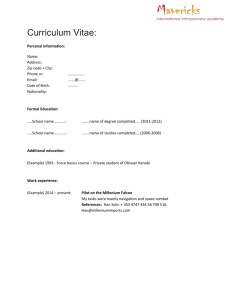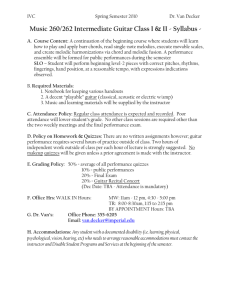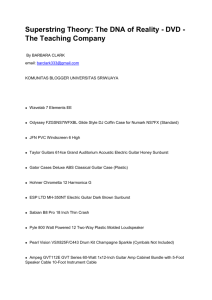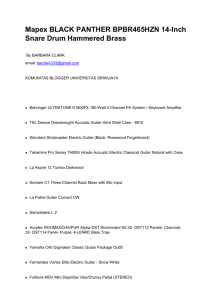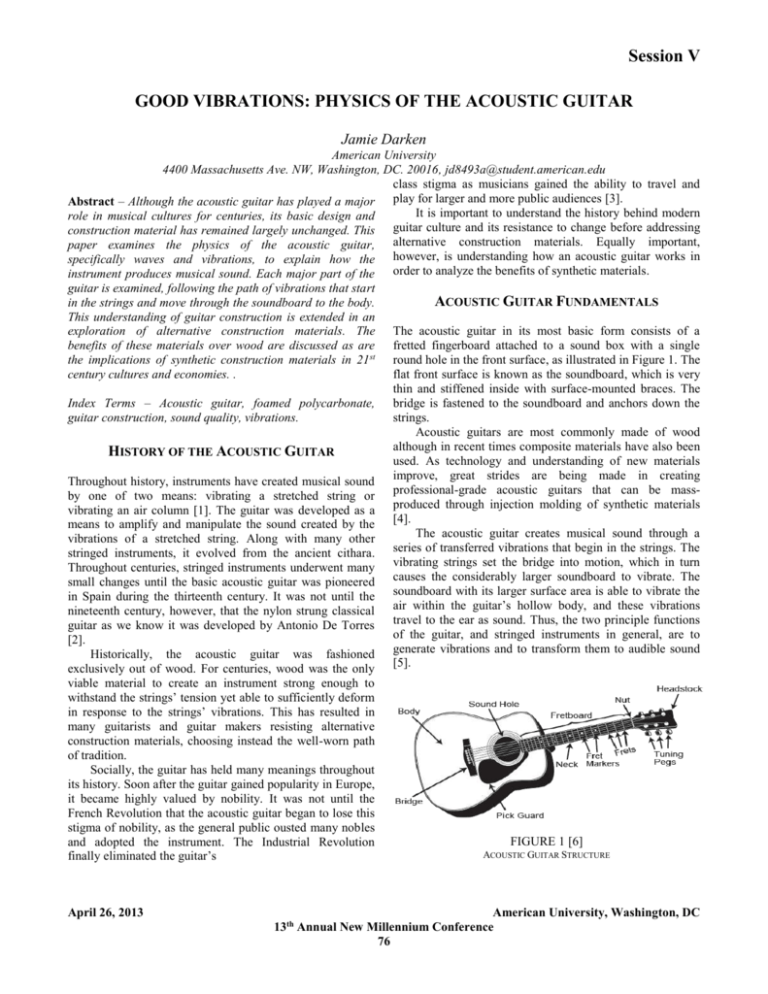
Session V
GOOD VIBRATIONS: PHYSICS OF THE ACOUSTIC GUITAR
Jamie Darken
American University
4400 Massachusetts Ave. NW, Washington, DC. 20016, jd8493a@student.american.edu
class stigma as musicians gained the ability to travel and
Abstract – Although the acoustic guitar has played a major play for larger and more public audiences [3].
It is important to understand the history behind modern
role in musical cultures for centuries, its basic design and
construction material has remained largely unchanged. This guitar culture and its resistance to change before addressing
paper examines the physics of the acoustic guitar, alternative construction materials. Equally important,
specifically waves and vibrations, to explain how the however, is understanding how an acoustic guitar works in
instrument produces musical sound. Each major part of the order to analyze the benefits of synthetic materials.
guitar is examined, following the path of vibrations that start
ACOUSTIC GUITAR FUNDAMENTALS
in the strings and move through the soundboard to the body.
This understanding of guitar construction is extended in an
exploration of alternative construction materials. The The acoustic guitar in its most basic form consists of a
benefits of these materials over wood are discussed as are fretted fingerboard attached to a sound box with a single
the implications of synthetic construction materials in 21 st round hole in the front surface, as illustrated in Figure 1. The
century cultures and economies. .
flat front surface is known as the soundboard, which is very
thin and stiffened inside with surface-mounted braces. The
Index Terms – Acoustic guitar, foamed polycarbonate, bridge is fastened to the soundboard and anchors down the
guitar construction, sound quality, vibrations.
strings.
Acoustic guitars are most commonly made of wood
although
in recent times composite materials have also been
HISTORY OF THE ACOUSTIC GUITAR
used. As technology and understanding of new materials
Throughout history, instruments have created musical sound improve, great strides are being made in creating
by one of two means: vibrating a stretched string or professional-grade acoustic guitars that can be massvibrating an air column [1]. The guitar was developed as a produced through injection molding of synthetic materials
means to amplify and manipulate the sound created by the [4].
The acoustic guitar creates musical sound through a
vibrations of a stretched string. Along with many other
series
of transferred vibrations that begin in the strings. The
stringed instruments, it evolved from the ancient cithara.
vibrating
strings set the bridge into motion, which in turn
Throughout centuries, stringed instruments underwent many
causes
the
considerably larger soundboard to vibrate. The
small changes until the basic acoustic guitar was pioneered
soundboard
with its larger surface area is able to vibrate the
in Spain during the thirteenth century. It was not until the
air
within
the
guitar’s hollow body, and these vibrations
nineteenth century, however, that the nylon strung classical
travel
to
the
ear
as sound. Thus, the two principle functions
guitar as we know it was developed by Antonio De Torres
of
the
guitar,
and
stringed instruments in general, are to
[2].
generate
vibrations
and to transform them to audible sound
Historically, the acoustic guitar was fashioned
[5].
exclusively out of wood. For centuries, wood was the only
viable material to create an instrument strong enough to
withstand the strings’ tension yet able to sufficiently deform
in response to the strings’ vibrations. This has resulted in
many guitarists and guitar makers resisting alternative
construction materials, choosing instead the well-worn path
of tradition.
Socially, the guitar has held many meanings throughout
its history. Soon after the guitar gained popularity in Europe,
it became highly valued by nobility. It was not until the
French Revolution that the acoustic guitar began to lose this
stigma of nobility, as the general public ousted many nobles
and adopted the instrument. The Industrial Revolution
finally eliminated the guitar’s
April 26, 2013
FIGURE 1 [6]
ACOUSTIC GUITAR STRUCTURE
American University, Washington, DC
13th Annual New Millennium Conference
76
Session V
Given these functions, several generalizations about
good guitar design can be made. The strings must be
uniform flexible so that they create consistent vibrations. In
addition, the guitar itself must have rigid supports that can
withstand the enormous tension of the strings, but these
supports and the body must also be able to deform in
response to the strings’ vibrations without warping over
time. These design characteristics all have their roots in one
area of physics: waves and sound.
WAVES AND SOUND
To understand the physics of the acoustic guitar, it is first
necessary to understand how waves and sound generally
behave. A mechanical wave is defined as a disturbance
propagated through a material medium [7]. There are two
main types of mechanical waves: transverse and
longitudinal. Transverse waves are created when the motion
of the medium’s particles is at right angles to the motion of
the wave as seen in Figure 2 [8]. Longitudinal waves are
created when the particles of the medium move in the same
direction of the wave. As the particles move, they go
through a series of compressions and rarefactions, which
constitutes the wave [9].
In terms of wave motion, simple harmonic motion lies
at the heart of musical sound. Simple harmonic motion
(SHM) has two key characteristics: the motion takes place
symmetrically about an equilibrium position and the motion
repeats itself in a definite time interval [13]. It is specifically
SHM that allows instruments to create musical sound waves.
An important characteristic of general wave motion, in
this case specifically SHM, is frequency, or how often a
vibration occurs. Frequency is measured in hertz (Hz),
which is the number of vibrations per second. When
musicians refer to musical notes like A or F sharp, they are
referring to a specific frequency that their instrument is
producing. There are many different patterns of string
tunings for acoustic guitars, but the most common tuning is
expressed in both frequency and note in Table I.
TABLE I
FUNDAMENTAL FREQUENCIES OF GUITAR STRINGS
String
1
2
3
4
5
6
Note
E2
A2
D3
G3
B3
E4
Frequency
82
110
147
196
247
330
Another important characteristic is wavelength, or the
distance between two crests of a wave. Wavelength and
frequency together relate to the speed of the wave, given by
v = f
FIGURE 2 [10]
A TRANSVERSE WAVE CREATED BY MOVING A STRING UP AND
DOWN
Sound waves are longitudinal, typically propagating
through air, and the source of sound is a vibrating object. For
example, the tuning fork in Figure 3 is vibrating and causing
the air around it to compress and rarify, thus creating sound
waves [11].
(1)
where v refers to wave speed in meters per second, f
refers to frequency in hertz, and refers to wavelength in
meters.
In relation to the acoustic guitar, these properties of
wave motion can be applied to the SHM of the vibrating
guitar strings, which is where the production of musical
sound begins.
VIBRATIONS IN A STRING
The musical sound of the acoustic guitar is born from the
vibrations of the strings. When a string is plucked, it is set
into periodic motion and vibrations propagate outward from
the point of contact. In the case of the acoustic guitar, these
vibrations reach each fastened end of the string and are
reflected back along the string in the opposite direction. This
creates what is known as a standing wave, as shown in
Figure 4
FIGURE 3 [12]
THE COMPRESSION AND RAREFACTION OF AIR TO CREATE SOUND
April 26, 2013
American University, Washington, DC
13th Annual New Millennium Conference
77
Session V
where v refers to wave speed in meters per second, T
refers to the tension in the string in Newtons, and refers
to the sting’s linear mass density in kilograms per meter.
Linear mass density is given by (3):
.
m
=
L
FIGURE 4 [14]
At certain frequencies, standing waves have important points
called nodes and antinodes at which there is zero
displacement and maximum displacement, respectively [15].
The strings in the guitar will vibrate with several
frequencies at once: the fundamental frequency, determined
by the vibration of the string as a whole, and overtones, or
harmonics, which are created by sectional vibrations [16].
The fundamental frequency of a string in a guitar is the
principal tone that is heard while harmonic overtones give
the sound its timbre, or characteristic color. Each instrument
excites overtones in a unique way depending on factors like
construction material and the manners by which it transfers
vibrations. Differences in timbre between instruments result
in many different possible sounds to be created even as the
instruments play the same note.
FUNDAMENTAL FREQUENCY
Generally, the range of fundamental frequencies that can be
created on an acoustic guitar is 80Hz to 1320 Hz [17]. Using
knowledge of wave behavior and a string’s characteristics
such as length and density, the fundamental frequency of a
given guitar string can be determined [18]. First, the velocity
of a transverse wave in string is given by (2):
v=
April 26, 2013
T
(3)
where m refers to the string’s mass in kilograms and L
refers to its length in meters. Since a vibrating guitar string
end
has a node at each
where it is fastened, it can be
determined that the fundamental standing wave in the string
has a wavelength that is twice the length of the
string. Thus,
it is possible to equate (2) to (1) and determine a general
equation for the fundamental frequency of a string in (4):
f=
A STANDING WAVE’S FUNDAMENTAL FREQUENCY AND OVERTONES
1 T
2L
(4)
This equation sheds light on the relationship between
the characteristics of a string and that string’s fundamental
(4) shows that longer and denser strings
frequency. Equation
will have a lower fundamental frequency since larger values
for L and in the denominators will result in a smaller
quotient. Additionally, higher tension in the string will result
in a higher fundamental frequency produced since a larger
value for T will result in a larger quotient. These
relationships explain why the guitar is played by holding
down the strings at the frets. In doing so, the performer is
shortening the length of the string while keeping every other
characteristic constant, thus raising the fundamental
frequency that is heard. The fundamental frequency alone,
however, does not make up the full sound of an acoustic
guitar.
OVERTONES
In addition to the fundamental frequency, a number of
higher frequencies at integer multiples of the fundamental
will also occur as a result of specific sections of the guitar
string vibrating on their own in different ways. These higher
frequencies are known as overtones. Thus, the sound made
by an acoustic guitar is a complex tone. According to
Fourier’s theorem, this complex tone can be thought of as
the sum of many pure tones of varying amplitudes, as
illustrated in Figure 5 [19]. In this case, it is the sum of the
fundamental frequency and its overtones.
(2)
American University, Washington, DC
13th Annual New Millennium Conference
78
Session V
FIGURE 5 [20]
HOW THE FUNDAMENTAL FREQUENCY AND OVERTONES CREATE A
COMPLEX TONE
It is these overtones that give the acoustic guitar, and any
other instrument, its sound quality, or timbre.
The timbre, or characteristic color, of the guitar’s sound
can be affected by the location of the pluck. When plucked
near the middle, the fundamental frequency vibrates with
higher amplitude than do the overtones, giving the tone a full
and lower sound. However, when plucked near the end,
higher harmonics are more strongly excited, which gives the
guitar a bright and brassy sound [21].
Strings are not only the source of the vibrations that
create musical sound in a guitar, but they can affect the
guitar’s sonic character. The next step in the production of
musical sound in an acoustic guitar has an even larger
impact on the overall sound quality of the guitar itself.
the soundboard transfers sufficient amplitude to be heard.
Likewise, the soundboard should have a smooth response; it
should accurately convey the relative levels of the
fundamental frequency and the overtones.
The soundboard also provides structural support. When
perfectly in tune according to Table I, the tension in the
strings is about 1000N. The soundboard must be able to
withstand this force yet still be able to be forced to vibrate
by the strings. Thus, a high stiffness to mass ratio is desired;
a good soundboard should be very stiff to prevent warping
or breaking but it should have as little mass as possible in
order to more easily be set into motion by the strings’
vibrations [23].
To prevent an actual collapse of the material while still
maintaining desirable acoustic properties, various patterns of
wooden reinforcements have been designed for the
soundboard. These reinforcements are called bracing.
BRACING
A crucial aspect of the soundboard is the underside bracing.
In almost every acoustic guitar, pieces of wood are glued to
the bottom of the soundboard within the body of the guitar.
This bracing serves a dual function: to provide structural
support and to improve tonal quality. The most common
bracing pattern is known as ‘X’ bracing seen in Figure 6.
THE SOUNDBOARD
The next step in the sequence of the production of musical
sound by an acoustic guitar is the soundboard. The
soundboard is the 2-3mm thin, flat front surface of the
guitar. It is the soundboard’s job to receive and to amplify
the strings’ vibrations. As it is set into motion, it increases
the amount of air that is also set into vibration. The
soundboard achieves significant amplification due to its
large surface area.
It is largely agreed upon by guitarists and guitar makers
that the soundboard is the most important characteristic of
the acoustic guitar in terms of the creation of a good tone
[22]. Also, the soundboard provides a crucial structural
function since it must support the tension of the strings.
In terms of guitar tone, a good soundboard should fulfill
needs relating to timbre, projection, and response. Although
timbre is perhaps the most important aspect of a good tone,
different timbres are desired for different types of guitar
playing. Therefore, timbre is highly subjective; there is no
single best timbre for a good soundboard to achieve.
Projection refers to the loudness of the guitar. Since the
soundboard dramatically increases the surface area that
forces the air to vibrate, it is important that in this process
April 26, 2013
FIGURE 6 [24]
AN ‘X’ BRACING PATTERN
Most woods chosen for their superior tonal qualities,
such as spruce and cedar, are not strong enough to withstand
the 1000N tension of the strings. These woods’ weakness
lies in their across grain fragility [25]. Although the wood
may be strong enough to support the string tension parallel
to its grain, the tension will cause warping and damage in
the direction perpendicular to the wood grain. Due to its
shape, X bracing provides stiffness in both directions and
significantly strengthens the soundboard.
In terms of sound quality, pieces of wood, or sound
bars, are used to divide the soundboard into different
sections and to transfer vibrations from the bridge to these
American University, Washington, DC
13th Annual New Millennium Conference
79
Session V
different sections. Each of these different sections can be
thought of as a mini soundboard, each one with a different
resonant frequency. The purpose of these mini soundboards
is to affect how the overtones of the guitar sound. Different
overtones can be better heard as they excite the mini
soundboards.
The pattern of sound bar placement is a highly debated
topic amongst guitarists and guitar makers since it can have
drastic effects on the guitar’s timbre and sound quality. For
example, Antonio Torres’ design, which is still commonly
used, consists of seven long and flexible sound bars arranged
in a fan shape that pass over the bridge as seen in Figure 7.
On the other hand, the Kasha design relies on many short
and stiff sound bars that emanate from the bridge. In the end,
the personal taste of the guitarist and guitar maker play a
large part in the bracing design [26].
Resonance refers to the creation of large vibrations in a
body by relatively small periodic forces that are in step with
the natural frequency of the body [28]. A body’s natural
frequency is the frequency that requires the least amount of
energy to force the body to vibrate. In the case of the
acoustic guitar, the small periodic forces are the forced
vibrations in the soundboard and the resonating body is the
air within the guitar. Due to the air’s relatively high volume,
this air is excited mostly by the lower frequencies of the
guitar.
FIGURE 8 [29]
A BASIC HELMHOLTZ RESONATOR
FIGURE 7 [27]
TORRES’ BRACING DESIGN
Although the soundboard plays a major role in the guitar’s
sound quality, it is still not enough to produce musical sound
at a sufficient volume. The vibrations must go through one
last step, the body, before they become what we know as the
sound of a guitar.
THE BODY: A HELMHOLTZ RESONATOR
The body of the guitar is the hollow cavity that the
soundboard covers. As the soundboard vibrates, it forces the
air within the body to vibrate as well, thus producing the
sound of the acoustic guitar. The body serves to increase the
loudness of the sound through a principle known as
resonance.
April 26, 2013
The body of an acoustic guitar can be classified as a
specific type of resonator: a Helmholtz resonator, as seen in
Figure 8. Helmholtz resonators consist of a container with
one or two openings, the smaller of which is called the neck.
As the air within the container is forced to vibrate, it acts
like a spring on the mass of the air in the neck. When the
natural frequency of the air in the container is matched, it
will greatly excite the air in the neck, thus creating a
relatively loud sound.
In the case of the acoustic guitar, the sound hole acts as
the neck. As the air inside the body is forced to vibrate by
the soundboard, it acts as a spring on the air around the
sound hole and pushes it in and out in time with the
vibrations. In this way, even more air is forced to vibrate at
the frequency transferred from the soundboard to the air
inside the body.
The air inside the body is crucial, but it is also important
to consider the material that makes up the body itself.
American University, Washington, DC
13th Annual New Millennium Conference
80
Session V
ALTERNATIVE CONSTRUCTION MATERIALS
Historically, the acoustic guitar has been exclusively
fashioned out of wood. This trend continues even today,
with the most popular construction materials for acoustic
guitars being coniferous softwoods like alpine spruce, sitka
spruce, adriondack spruce, and western red cedar [30]. These
types of wood are valued for their inherent acoustic
qualities, although little is understood about the precise
relationship between acoustics and the wood’s nature.
With recent technological developments, efforts have
been made to use synthetic materials to mimic the strengths
of wood as a guitar construction material while rectifying its
weaknesses. Several synthetic materials that are gaining
popularity in acoustic guitar construction are high pressure
laminate, which is a wood composite, and carbon fiber
plastic. These materials are sufficiently rigid, yet
simultaneously able to deform, to make bracing superfluous.
One type of alternative construction material, foamed
polycarbonate, is beginning to redefine understanding of the
ideal construction material. A guitar with a foamed
polycarbonate soundboard can be seen in Figure 9.
Specifically, foamed polycarbonate has shown that a high
stiffness to mass ratio is not necessarily a requirement for
desirable guitar tone and structure. Rather, the
microstructure of the material probably plays a larger role
than previously thought in affecting the acoustics of the
guitar. This is evidenced by the fact that another material,
foamed polyvinylchloride, with a stiffness to mass ratio
similar to that of foamed polycarbonate was considered
“acoustically dead” in tests [31].
Foamed polycarbonate exhibits several desirable
characteristics in terms of acoustic guitar design.
Acoustically, it has been found to sound similar to cedar,
and thus it reaches the high tonal quality achieved by this
type of wood. Additionally, this material has particularly
strong bass response. Structurally, it lacks the cross-grain
weaknesses of wood and thus provides a stronger and more
reliable guitar. Finally, foamed polycarbonate performs well
in a wide range of temperatures and is resistant to changes in
humidity. Wood, on the other hand, is notorious for warping
in response to changes in temperature and humidity. In this
way, foamed polycarbonate rectifies several weaknesses of
wood as a material for acoustic guitars.
While the possibilities of synthetic materials such as
foamed polycarbonate are beginning to be explored, there is
still much to learn before such materials can be practically
deployed. At this point, experimentation with alternative
construction materials is a crucial step towards developing
guitars in the future.
April 26, 2013
FIGURE 9 [32]
A GUITAR WITH A FOAMED POLYCARBONATE SOUNDBOARD
THE FUTURE OF GUITAR DESIGN
In relation to the world’s economy, synthetic materials can
revolutionize how guitars are constructed and distributed
across the globe. As the popularity of the instrument
continues to grow, a physical analysis of guitar construction
can give crucial insight into how to more effectively
construct guitars, thus bringing the guitar into the 21 st
century in terms of technology and economics.
Historically, the construction of acoustic guitars was left
to highly skilled artisans called luthiers. Luthiers’ guitar
designs, although intricate and refined, were based
exclusively on trial and error.
Today, as the world’s population has grown in tandem
with the popularity of the guitar, acoustic guitar production
has largely been relegated to the factories of East Asian
countries. A focus on mass production as well as a lack of
acoustic guitar knowledge has resulted in the proliferation of
entry-level acoustic guitars that not only sound inferior but
are difficult to play.
Guitar makers are exploring ways to create high quality
synthetic-material guitars that fit the tastes of musicians
while also conforming to the high production demands of the
modern world. Specifically, materials like foamed
polycarbonate are suitable for injection molding, which is
ideal for factory production as it is fast and does not require
intimate knowledge of delicate shaping of wood.
American University, Washington, DC
13th Annual New Millennium Conference
81
Session V
SUMMARY
Although the acoustic guitar has existed for centuries, its
design has hardly changed. This stagnation is due in part to
cultural taste as well as a lack of technical knowledge of the
physics of guitar construction and sound production.
Today, advanced understandings of physics have
surpassed the previous trial-and-error method of guitar
design. Physics can be used to bring the guitar into the 21 st
century while not violating cultural taste in terms of
desirable guitar tone.
The best way to accomplish this is through the
exploration of alternative construction materials for acoustic
guitars. Although the exact effects of microstructure on the
acoustics of the guitar are not well understood, it has been
discovered that the makeup of the material may have a
significant effect on its tonal quality. In this way,
technological advances in the production of synthetic
materials can offer a way to produce inexpensive, high
quality acoustic guitars, thus moving an ancient and beloved
tradition into the future.
6D1FDCAD-5AC2-43EA8B7865D5B71A8709&Image_Type=image.
[25] Ref. 2.
[26] Eendebak, B, “The Soundboard.” Design of a Classical Guitar. 2011.
Web. 27 Feb. 2013.
http://designofaclassicalguitar.com/soundboard.php.
[27] “How to Build a Guitar – Part 4. Bracing the Soundboard.” Gideon’s
Guitar Pages. 2013. Web. 27 Mar. 2013.
http://gidsguitars.wordpress.com/how-to-build-a-guitar-part-4bracing-the-soundboard.
[28] Ref. 11.
[29] “File: Helmholtz resonator.jpg.” Wikimedia Commons. 8 Nov. 2012.
Web. 10 Apr. 2013.
http://commons.wikimedia.org/wiki/File:Helmholtz_resonator.jpg
[30] Ref. 2.
[31] Ref. 2.
[32] “The Guitar: Overview.” Secret Valentine. 2012. Web. 28 Mar. 2013.
http://www.coolacoustics.com/sv/overview.php?CurrentSection=over
view
REFERENCES
[1] Rigden, John S, Physics and the Sound of Music, New York: Wiley,
1977.
[2] Armstrong, Rob and Eddie Norman and Owain Pedgley, “MaterialsInspired Innovation for Acoustic Guitar Design”, METU Journal of
the Faculty of Architecture, Vol. 26, No. 1, 2009, pp. 157-175.
[3] Findlay, Sharon. “The Evolution of the Guitar.” Faze, Faze. 2013. Web.
28 Mar. 2013.
http://www.faze.ca/issue04/evolution_of_the_guitar.html.
[4] Ref. 2
[5] White, Donald H and Harvey E White, Physics and Music: The Science
of Musical Sound, Philadelphia: Saunders College, 1980.
[6] “Need to Know the Parts of the Acoustic Guitar?” Guitar on the Spot.
On the Spot Publishing. Web. 21 Feb. 2012. http://www.guitar-on-thespot.com/image-files/acousticguitar.gif.
[7] Ref. 1.
[8] Hewitt, Paul G, Conceptual Physics, 11th ed. San Francisco: Pearson
Addison Wesley, 2010.
[9] Ref. 5.
[10] Ref. 8.
[11] Ref. 1.
[12] Ref. 8.
[13] Ref. 1.
[14] Ref. 8.
[15] Ref. 5.
[16] Lloyd, LI. S, Music and Sound, London: Oxford University Press:
1937.
[17] French, M and D. Hosler, “The Mechanics of Guitars”, Experimental
Techniques, Vol. 25, No. 3, 2001, pp. 45-48.
[18] Stewart, George W, Introductory Acoustics, New York: Van Nostrand,
1932.
[19] Ref. 5.
[20] Ref. 8.
[21] Ref. 5.
[22] Ref. 2.
[23] Ref. 2.
[24] Somogyi, Ervin, “What Makes an Acoustic Tick?” Premier Guitar.
2013. Web. 22 Feb. 2013.
http://www.premierguitar.com/Stream/StreamImage.aspx?Image_ID=
April 26, 2013
American University, Washington, DC
13th Annual New Millennium Conference
82



